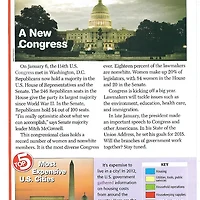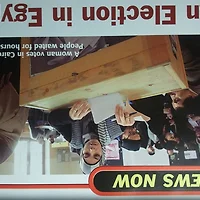Trouble in North Korea
As tensions rise between the neighboring countries,
North Korean officials warn foreigners to leave South Korea
A South Korean soldier sets up a barricade on a bridge that connects South and North Korea.
You may have heard about North Korea in the news recently.
The secretive, communist country has a troubled relationship with many nations, including South Korea
and the United States. Why is this small country currently causing so much concern?
A Rising Threat
Kim Jong Un is the leader of North Korea. His father, Kim Jong Il, led the country from 1994 until 2011.
Both leaders have used military threats to display their power and control.
North Korea has one of the world's largest armies, with access to destructive nuclear weapons.
On Tuesday, North Korean officials warned all foreigners to leave South Korea for their own safety.
Though the U.S. and South Korea say they have not seen any military movement or clear signs
that nations are on the brink of a war, tensions are high.
Many countries, including the United States, have spoken out against North Korea.
On Monday, China’s President, Xi Jinping, said no country “should be allowed to throw a region
and even the whole world into chaos for selfish gain."
A Long History of Conflict
North Korea and South Korea share a history, a language and a peninsula.
But for more than 60 years, conflict and distrust have separated the nations.
Korea was a colony of Japan from 1910 to 1945.
After Japan’s defeat in World War II, Korea was divided into two countries.
The split became permanent in 1948. North Korea established a communist government.
South Korea became a republic. Each wanted to reunify Korea under its own government.
On June 25, 1950, the North Korean military invaded South Korea, starting the Korean War.
A cease-fire agreement was signed in July 1953.
A demilitarized zone (DMZ) was created along the border dividing North and South.
Soldiers patrol each side of the DMZ. Millions of families are separated.
Tension between the two nations runs high.
While South Korea has become an industrial giant, North Korea has many economic problems.
In years past, South Korea tried to improve relations by giving aid to North Korea.
But the North has not let down its guard, continuing to grow its army and nuclear-weapons program.
Because of this, South Korea and the U.S. stopped food aid to North Korea.
On February 12, North Korea conducted an underground nuclear test.
It was the country’s third nuclear test since 2006.
Two weeks later, South Korea’s new President, Park Geun-hye, took office.
In her first official speech as President, she called North Korea’s nuclear program “
a challenge to the survival and future of the Korean people.”
Park has said she hopes to engage North Korea in talks and build trust through aid.
But it appears that North Korea may not be willing to meet South Korea halfway.
halfway***********************************************************************************************************
We will try to meet halfway. 우리는 타협하도록 할 것이다.
We decided to meet the company halfway. 우리는 그 회사와 타협하기로 했다.
'타임포키즈 > 과월호NS' 카테고리의 다른 글
| 2015년 3월 News Scoop : News Now - p2 (0) | 2015.03.15 |
|---|---|
| 2015년 3월호 News Scoop (0) | 2015.03.15 |
| 2012년 3월 News Scoop Edition : NEWS NOW (0) | 2012.03.30 |
| 2012년 2월 News Scoop Edition : NEWS NOW (0) | 2012.02.10 |
| Entertainment - A Whale of a Tale (0) | 2012.02.05 |



